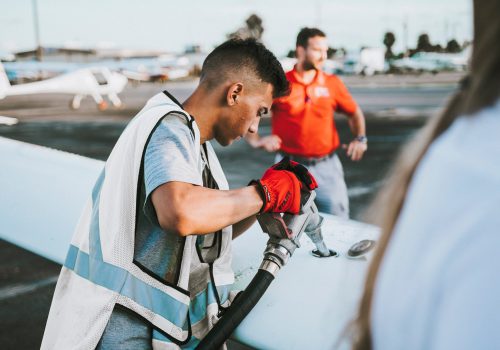The challenge
Even in the medium-long term, sustainable aviation fuels (SAF) will be needed. It is critical to increase the availability of SAF and specifically, facilitate a process that will result in increasing volumes of Power-to-X based SAF towards 2030.
The key barrier is the price gap between conventional fuels and SAF. Currently, they are 2-5 times higher, and as fuel costs represent approximately 20 per cent of an airline’s cost base, it is vital to introduce some kind of funding mechanis...
Even in the medium-long term, sustainable aviation fuels (SAF) will be needed. It is critical to increase the availability of SAF and specifically, facilitate a process that will result in increasing volumes of Power-to-X based SAF towards 2030.
The key barrier is the price gap between conventional fuels and SAF. Currently, they are 2-5 times higher, and as fuel costs represent approximately 20 per cent of an airline’s cost base, it is vital to introduce some kind of funding mechanism until a reasonable level of economies of scale is established. The proposal for a climate fund financed by a small passenger
contribution shall be seen in this perspective.
The potential
Key objectives for the Danish aviation sector in reducing CO2e emissions
- Minimum 70 per cent CO2e reduction on domestic air travel by 2030 compared to 1990 levels
- Minimum 30 per cent CO2e reduction on international air travel by 2030 compared to 2017
- Ultimately: to achieve climate neutrality by 2050
Recommendations
A global CO2e/fuel tax is recommended as the most efficient mechanism for reducing emissions. A return loop of funds to facilitate the cost of transition (covering the price gap of SAF) will speed up the process and safeguard a level playing field
However, a global tax (or EU-based) will take time. To get started on a national level, the climate partnership recommends the establishment of a national aviation climate fund financed by a small contribution from each departing passenger. Approximately EUR 4 per person can finance the fund by EUR 67.2 million annually
Power-to-X is an ultimate tool to effect the transition. A master plan for green power and Carbon Capture, Utilitisation and Storage (CCUS) is needed in due time

The Climate Partnership for Aviation
Want to learn more about the climate partnership and explore the government and industry recommendations more in-depth? Fill in your information below and download the highlights
About the partnership
Chairman
Anko van der Werff, CEO, SAS
Vice chairman
Christian Poulsen, CEO, Copenhagen Airports
Private partners
Danish Aviation at Danish Transport Federation
20+ committee – representatives from airlines, airports, NGO’s, unions, scientists and consultancies
Public partners
Ministry of Transport


